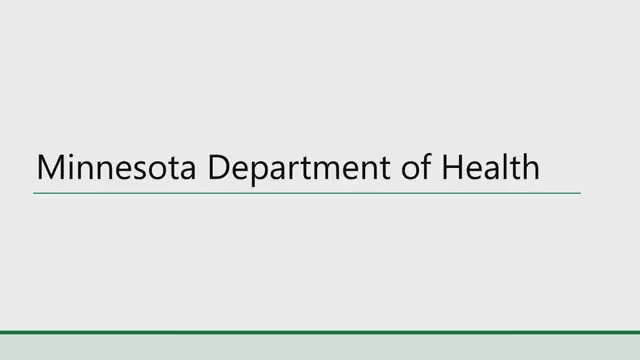Staff briefs committee on Minnesota Department of Health budget, programs and public-health responsibilities
January 15, 2025 | 2025 Legislature MN, Minnesota
This article was created by AI summarizing key points discussed. AI makes mistakes, so for full details and context, please refer to the video of the full meeting. Please report any errors so we can fix them. Report an error »

House nonpartisan staff reviewed the Minnesota Department of Health’s (MDH) size, funding sources and program areas for the House Health Finance and Policy Work Group on Jan. 15.
Why it matters: MDH administers public-health programs, licensing, disease surveillance and grants that affect local public-health agencies, health-care providers and communities across Minnesota; its budget and program priorities shape statewide prevention and response capacity.
Staff said MDH is a large agency across all funds, with about half of its funding from federal sources, roughly 27% from the general fund and additional amounts from special-revenue accounts. The presentation reported a combined all-funds balance for MDH in the upcoming biennium of about $1.8 billion and listed base FTE counts of 1,873 in FY26 and 1,708 in FY27 (staff cautioned those FTE figures are not additive across years).
Elizabeth Clarkvist of House Research outlined MDH program areas: public health (health equity offices, WIC, home visiting, Children and Youth with Special Health Needs), health promotion and chronic-disease work (including cancer reporting and SAGE screening), environmental health (indoor-air and lead programs, drinking-water protection, food, lodging and pool regulation), infectious disease surveillance and response (STD, HIV, tuberculosis, public-health lab operations), and regulation of health facilities and providers (licensing/certification, complaint investigations, facility surveys). Clarkvist said the Public Health Lab conducts newborn screening for more than 60 rare disorders and provides specialized testing for outbreaks.
Staff also described health-care reform and quality programs administered or supported by MDH: the All Payer Claims Database, the Statewide Quality Reporting and Measurement System (SWORMS), health-care homes care-coordination payments and the Center for Health Care Affordability — a 2023 statutory initiative to research drivers of health-care costs and identify reforms.
Staff noted MDH’s role working with local community health boards (51 boards statewide) and with tribal governments; some duties for local boards arise from statute and others through delegation agreements. The presentation said MDH distributes federal and state grant dollars to community health boards and other grantees.
Committee members asked several clarifying questions during the Q&A portion, including where vital-records data are held and whether termination-of-pregnancy data are collected through the Office of Vital Records; staff responded that termination-of-pregnancy counts are reported through a separate termination-of-pregnancy report and not via the vital-records office, and staff offered to follow up with the committee with the specific report data.
The briefing was informational; no committee votes or directives for MDH policy were made at the meeting.
Why it matters: MDH administers public-health programs, licensing, disease surveillance and grants that affect local public-health agencies, health-care providers and communities across Minnesota; its budget and program priorities shape statewide prevention and response capacity.
Staff said MDH is a large agency across all funds, with about half of its funding from federal sources, roughly 27% from the general fund and additional amounts from special-revenue accounts. The presentation reported a combined all-funds balance for MDH in the upcoming biennium of about $1.8 billion and listed base FTE counts of 1,873 in FY26 and 1,708 in FY27 (staff cautioned those FTE figures are not additive across years).
Elizabeth Clarkvist of House Research outlined MDH program areas: public health (health equity offices, WIC, home visiting, Children and Youth with Special Health Needs), health promotion and chronic-disease work (including cancer reporting and SAGE screening), environmental health (indoor-air and lead programs, drinking-water protection, food, lodging and pool regulation), infectious disease surveillance and response (STD, HIV, tuberculosis, public-health lab operations), and regulation of health facilities and providers (licensing/certification, complaint investigations, facility surveys). Clarkvist said the Public Health Lab conducts newborn screening for more than 60 rare disorders and provides specialized testing for outbreaks.
Staff also described health-care reform and quality programs administered or supported by MDH: the All Payer Claims Database, the Statewide Quality Reporting and Measurement System (SWORMS), health-care homes care-coordination payments and the Center for Health Care Affordability — a 2023 statutory initiative to research drivers of health-care costs and identify reforms.
Staff noted MDH’s role working with local community health boards (51 boards statewide) and with tribal governments; some duties for local boards arise from statute and others through delegation agreements. The presentation said MDH distributes federal and state grant dollars to community health boards and other grantees.
Committee members asked several clarifying questions during the Q&A portion, including where vital-records data are held and whether termination-of-pregnancy data are collected through the Office of Vital Records; staff responded that termination-of-pregnancy counts are reported through a separate termination-of-pregnancy report and not via the vital-records office, and staff offered to follow up with the committee with the specific report data.
The briefing was informational; no committee votes or directives for MDH policy were made at the meeting.
View full meeting
This article is based on a recent meeting—watch the full video and explore the complete transcript for deeper insights into the discussion.
View full meeting
